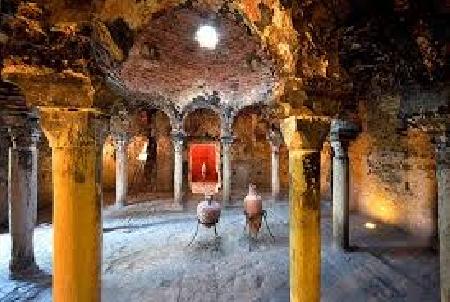 A striking example of Arab culture is the Arab baths located in the narrow streets of Palma de Mallorca, however all that has survived are two small rooms, a caldarium and a tepidarium. You can find them near the wonderful Cathedral, where a mosque once stood - along with the baths, the mosque was one of the main elements of Islamic life.
A striking example of Arab culture is the Arab baths located in the narrow streets of Palma de Mallorca, however all that has survived are two small rooms, a caldarium and a tepidarium. You can find them near the wonderful Cathedral, where a mosque once stood - along with the baths, the mosque was one of the main elements of Islamic life.
Passing through the luxurious walled garden of the Can Fontirroig Mansion, tourists find themselves in a caldarium, an elegant horseshoe room with 12 columns and a dome dating back to the 10th century. The dome is notable for its various holes through which escaped steam while the tub was used for its purpose. The columns with their capitals, by the way, were taken from an older Roman structure. Here you can also see various devices and an underground heating system. Once there were also cold baths - frigidarium, but, unfortunately, they are not preserved.
It is believed that the entire bath complex was part of the palace of a wealthy Muslim, located in Medina Mallorca (which is why during the centuries-old occupation of the island by the Moors it was called Palma de Mallorca). In total, there were about 20 such bathing complexes on the island, and all of them were privately owned. In 1229 King Jaime I of Aragon conquered the island and unfortunately almost all Islamic buildings were destroyed. The Arab baths have survived only by a miracle. Until the 1960s, they were used as farm outbuildings where farm animals roamed freely, and only later was the structure slightly renovated and opened to the public for a small fee.
Today, the Arab Baths, one of the few examples of Muslim architecture in the city, are also a popular tourist attraction in Palma.
The square room has twelve columns, which separate the central part of the room with a high vaulted ceiling from the main walls, near which they form galleries with barrel vaults. The columns are connected to the main parts of the room by horseshoe arches characterized by capitals with architectural decorations. These columns are likely borrowed from ancient buildings, some of which were built in Roman times. The central room of the hot baths also has twenty-five openings, including the ceiling (most of them are still closed). The openings were used to penetrate natural light and air into the room, as well as to release steam from the room. The floor of the room consisted of a double layer separated by spaces with holes through which hot air and water circulated to heat the floor and the room. Due to the soil temperature, the water quickly evaporated, creating an atmosphere of hot steam in the room.
Historians claim that these bathhouses belonged to the 11th century buildings and that they belonged to a wealthy Muslim. Unfortunately, today only the central hot room of the Arab baths has been preserved. The semi-circular room with columns ends in a dome with small windows. Bathrooms are built on the principle of a mix of urban styles, and in addition to the living room for hot baths there was once a changing room, a pre-bath and a cold room for invigorating baths.
Tours are open from 9:30 to 7 or 8 pm. The ticket price is 2 euros.
Address: Carrer de Can Serra, 7, 07001 Palma, Balearic Islands, Spain
Telephone: +34 637 04 65 34
